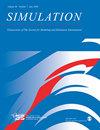室内通风设计与气溶胶输送的数值研究:以某医院大厅为例
IF 2
4区 工程技术
Q4 COMPUTER SCIENCE, INTERDISCIPLINARY APPLICATIONS
Simulation-Transactions of the Society for Modeling and Simulation International
Pub Date : 2023-09-06
DOI:10.1177/00375497231194348
引用次数: 0
摘要
室内气溶胶颗粒的输送与各种病毒的感染风险密切相关。当未来COVID-19大流行与人类共存时,公共建筑的气流分布设计变得更加重要,不仅是为了热舒适,而且通过控制室内气溶胶运输来预防疫情。本文以成都市崇州中医院某医院大厅为例,通过室内热舒适数值模拟和气溶胶输送过程分析,对室内空气的调节进行了研究。仿真结果表明,在夏季,适当的送风方式可以首先达到热舒适。在喷嘴、方形扩散器和呼吸平面的联合运行下,平均速度为0.26 m/s,平均温度和平均气龄分别为23.43℃和949.59 s。其次,对该医院大厅排风口的布置进行了重新设计和模拟,采用了三种新的排风口设计方案,其中地板排风方案最优,气溶胶排放速度最快(因此污染物排放能力最强),30秒内排放62%的气溶胶颗粒,150秒内排放99%的气溶胶颗粒。本研究成功地尝试了优化室内空气通风以防止COVID-19等病毒的空气传播,为医院大厅等人口密集区域的气流组织设计提供了可行的方案。本文章由计算机程序翻译,如有差异,请以英文原文为准。
A numerical investigation on indoor air ventilation design and aerosol transportation: a case study in a hospital hall
The transportation of indoor aerosol particles is closely related to the infection risk of various viruses. When the pandemic of COVID-19 is anticipated to coexist with human beings in the future, the design of airflow distribution in public buildings becomes more vital not only for thermal comfort but also for epidemic prevention through controlling indoor aerosol transportation. In this paper, the conditioning of indoor air in a hospital hall (Chongzhou Traditional Chinese Medicine Hospital in Chengdu, China) is case studied by numerically simulating the indoor thermal comfort and the aerosol transportation process analysis. Simulation results indicate that thermal comfort can be first achieved by appropriate air supply forms in summer. Under the combined operation of the nozzles, square diffusers, and the breathing plane, with an average velocity of 0.26 m/s, the average temperature, and the average air age are 23.43°C and 949.59 s, respectively. Second, the arrangement of air-exhaust outlets in this hospital hall is also redesigned and simulated with three new schemes of outlets design, of which the floor exhaust scheme is optimal with the fastest aerosol discharge speed (thus the strongest pollutant discharge capacity), i.e., 62% of aerosol particles discharged in 30 s and 99% of particles discharged in 150 s. This study makes a successful attempt to optimize indoor air ventilation for preventing airborne transmission of viruses, e.g., COVID-19, offering a feasible scheme for the air distribution design in densely populated areas such as hospital halls.
求助全文
通过发布文献求助,成功后即可免费获取论文全文。
去求助
来源期刊
CiteScore
3.50
自引率
31.20%
发文量
60
审稿时长
3 months
期刊介绍:
SIMULATION is a peer-reviewed journal, which covers subjects including the modelling and simulation of: computer networking and communications, high performance computers, real-time systems, mobile and intelligent agents, simulation software, and language design, system engineering and design, aerospace, traffic systems, microelectronics, robotics, mechatronics, and air traffic and chemistry, physics, biology, medicine, biomedicine, sociology, and cognition.

 求助内容:
求助内容: 应助结果提醒方式:
应助结果提醒方式:


